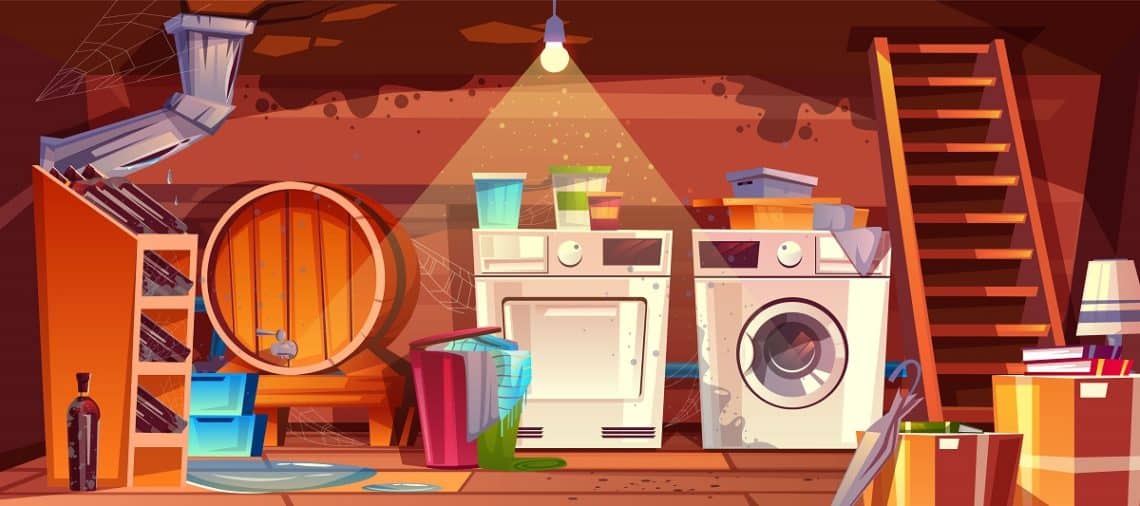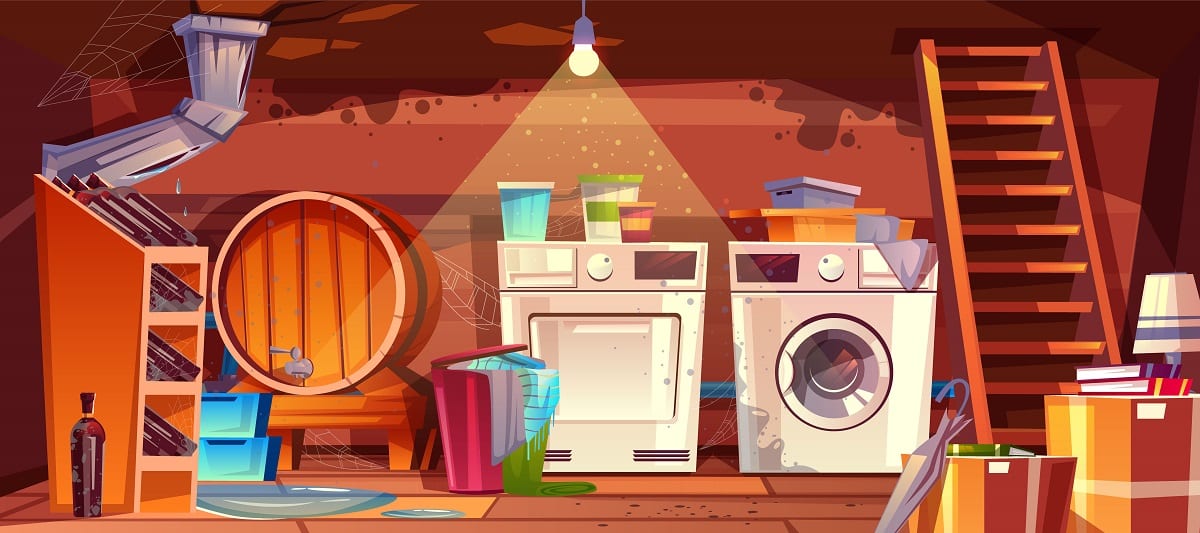Basements have a reputation for being dark and damp. But you need to keep an eye out for the moisture levels down there.
Too much moisture can lead to mold, mildew, and other types of biological growth – be it plants or god forbid insects. Left to themselves, the conditions will grow progressively worse and ultimately lead to rot and decay, architectural damage, untimely paint failure, and also a variety of other health problems.
How do you know when moisture is a problem?
A moderate amount of dampness is to be expected in every basement. However, it starts to be a bigger problem when you notice any of these signs:-
- Water dripping down the walls
- Rings of dampness at the base of your walls
- Condensation on the floor and walls
- The walls are stained with water and are peeling off
- Your floorboards and carpets are getting damaged
- A smell of rot and mildew
- Walls and floor wet to the touch
- Humid and heavy air
If you notice any of these symptoms, then it’s already time to take a step back, figure out what the problem is, and then find a solution.
Basement Moisture Causes and How to Fix Them
-
An indoor water leak
This is one of the most obvious reasons why your basement is overloaded with water and dampness. There’s a leak somewhere, and that leak is the root of all your problems.
Look for every appliance and utility that uses a regular flow of water like a shower, a sink, or a toilet. It doesn’t have to be bathroom fixtures, it could also be the washing machine, the dishwasher or maybe it’s just an old and broken pipe.
How To Fix It?
Just follow the trail of water to where it’s originating, and if you find a large pool of water somewhere, the faulty appliance should be nearby. Then just repair the leak or replace the pipe, or better yet, have a plumber do it.
-
Landscaping Flaws
The grading around your house should be such that the slope faces outwards, away from your home. Rain, sleet, snow, and everything else should slide away from your house and yard, out onto the street.
If the grading isn’t correct, water will accumulate against your house and eventually seep down into the basement. If the fill dirt surrounding your house has been insufficiently compacted, there’s an even higher risk of water seepage.
How To Fix It?
Apart from the obvious, which is hiring an architect to redo the sloping, you can take a few more precautionary measures to ensure this situation never comes to pass again –
- You can dig a trench across the perimeter of your house where the rainwater gets collected.
- You can line your whole house with rocks as a barricade against the groundwater. This makes for a very functional as well as an aesthetic addition to your house.
-
Misplaced or missing gutters
Gutters and downspouts are there to direct rainwater away from your house. If those troughs leak or if some shingles are missing, water could drip or fall down near the foundation of your house and slowly make its way inside.
If the gutters aren’t extended outwards sufficiently, it could lead to the same problem. Pipes running down your house is a strict no-go.
Even if you have gutters all around the house, they can get clogged by leaves or debris which will lead to a buildup of water, which will eventually give way. The same goes for snow, which suddenly thaws, and can threaten the structural integrity of your gutters.
How To Fix It
If there aren’t any downspouts, install them ASAP. All your downspouts should also expel the water at least 4 feet away from the foundation of the house.
-
Cracks In Concrete
As the house settles in, cracks in the foundation aren’t that unusual at all. In fact, cracks can happen even in newly poured concrete.
Cracks in the foundation walls, which form the ceiling and external structure of the basement can lead to a lot of water coming in from both the house above and inclement weather outside.
But the issue is, that sometimes water itself can cause these cracks. Or exacerbate cracks that were already there. If there’s water accumulating against the building walls, hydrostatic pressure can force this water into the cracks and eventually, into the house.
How To Fix It?
Some cracks can be easily repaired, without resorting to professional help. All you need is a chisel, a mallet, patching cement, and a putty knife. Just use the blade of the putty knife to put in some expanding cement.
Other cracks are harder to repair by yourself and definitely require professional help.
-
Dearth of drainage
Most old houses weren’t created keeping subterranean drainage systems in mind. Basements were initially intended to be shelters during times of dire emergency. It wasn’t just another room in the house.
However, most modern homes are outfitted with a drainage system in the basements. However, the drainage system can get compromised due to pressure from the ground or the house. Plenty of problems can arise, such as a clogged pipe, a misaligned connection, or a failing sump pump. All it takes is one malfunctioning piece to make the whole system fail.
How to fix it?
Unfortunately, fixing your drainage system involves digging up the old drainage system, removing it, and repairing it or putting in a new sump pump. All of this is a lot of work and is impossible without proper knowledge of plumbing and hydraulics.
If you suspect this is the case, contact some competent professionals so that you can ensure the problem gets solved once and forever.
-
Not Enough Circulation
Sometimes it’s not liquid water that’s the problem but damp air turning into water by condensation. This is a big problem, especially when the room isn’t getting enough circulation. The damp air gets stuck in the middle and keeps collecting moisture.
Then when it comes in contact with a colder surface (any metal surface is bound to be cooler) it instantly turns to water – this is essentially the same process that causes your can of beer to sweat on a hot and sweaty summer day.
This is particularly noticeable if you have a kitchen or a shower in your basement. Or if you have pipes and ducts running which are hooked up to air conditioners or refrigerators, basically any appliance which creates a stark difference in temperature between two nearby points of contact.
How To Fix It
It’s pretty simple. You need to give the damp air somewhere to go. We would suggest installing an exhaust fan or two, which takes the air out. If that is not possible, then just put in some fans which move the air around. This will distribute the moisture equally around the room, instead of focusing it on one spot.
Or you could cover up all the walls, ducts, and pipes with insulation so that the moisture-laden air never touches those surfaces.
-
Too much humidity
If there’s just too much humidity and there’s no way for you to expel the air, it’s bound to get very damp down there. If you can’t observe any noticeable water leakages yet the paint is peeling off the walls, and the whole place smells like a swamp, you definitely have a humidity problem.
Cold and moist air has a tendency to accumulate at the bottom and down in the basement. Sometimes, just putting in an exhaust fan or trying to move the air around really isn’t going to do much.
How To Fix It?
You need to get a robust dehumidifier suitable for a basement. Depending on the size and severity of humidity, you might even need 2. Most of the time, when an external leak is not the issue, a good, reliable dehumidifier will totally fix the problem.
-
The walls aren’t waterproof
Walls are particularly vulnerable to excess moisture in the room. And once these walls start wilting due to the moisture, it might lead to more cracks and faults which will lead to even more water seepage. This is a terrible cycle and needs to be stopped.
How To Fix It?
The basement should be waterproofed, either with extremely water-resistant paint or with a waterproofing membrane. The waterproofing method should insulate the basement against every form of water seepage and increase the durability of the basement by many years.
A strong waterproofing application should help the basement surface make it through foundation distress and changing landscapes. After all, the basement is supposed to be the most resilient room in your whole house.
-
Garden sprinklers, hoses, and other sources of water
You might have an automatic garden sprinkler that leaks water into the basement. Or the sump pump from below could be situated right beside your tool shed and above the basement.
Or maybe you just have a clothesline directly above the basement. A garden hose that you sometimes leave running right above the basement.
How To Fix It?
Keep an eye on anything which delivers moisture or water in the direction of your basement. You need to keep everything at least 4 feet away from the basement and point out to the street in front.
Conclusion
No matter what the cause is, if you see persistent excessive moisture inside your basement, don’t wait around any longer without doing anything about it.
The longer you let the problems fester, the worse it’s going to get, ultimately making the repairs more complicated and a lot more expensive.
Related Articles
14 Best Basement Flooring Options Right Now
13 Best Moisture Meters Right Now
50 Basement Bar Ideas To Rock Right Now
13 Best Moisture Meters Right Now Reviewed | Buyer’s Guide
7 Best Mold Detection Kits to Consider Today [Buyer’s Guide]
9 Best Crawl Space Dehumidifiers | Reviews + Guide
How to Get the Best Soundproofed Basement Ceiling




